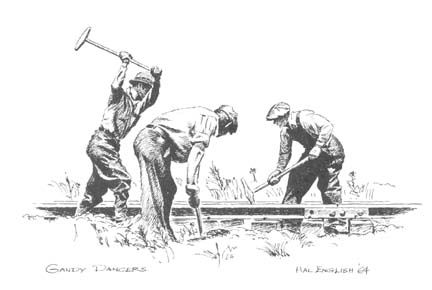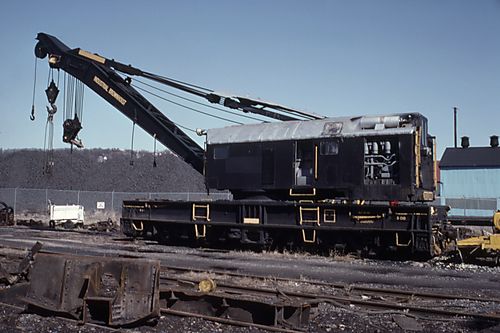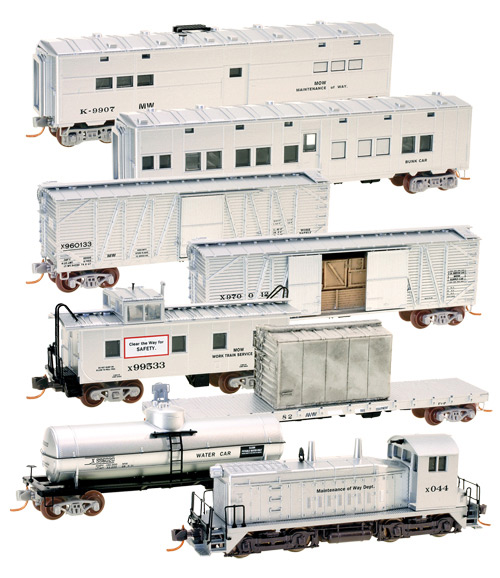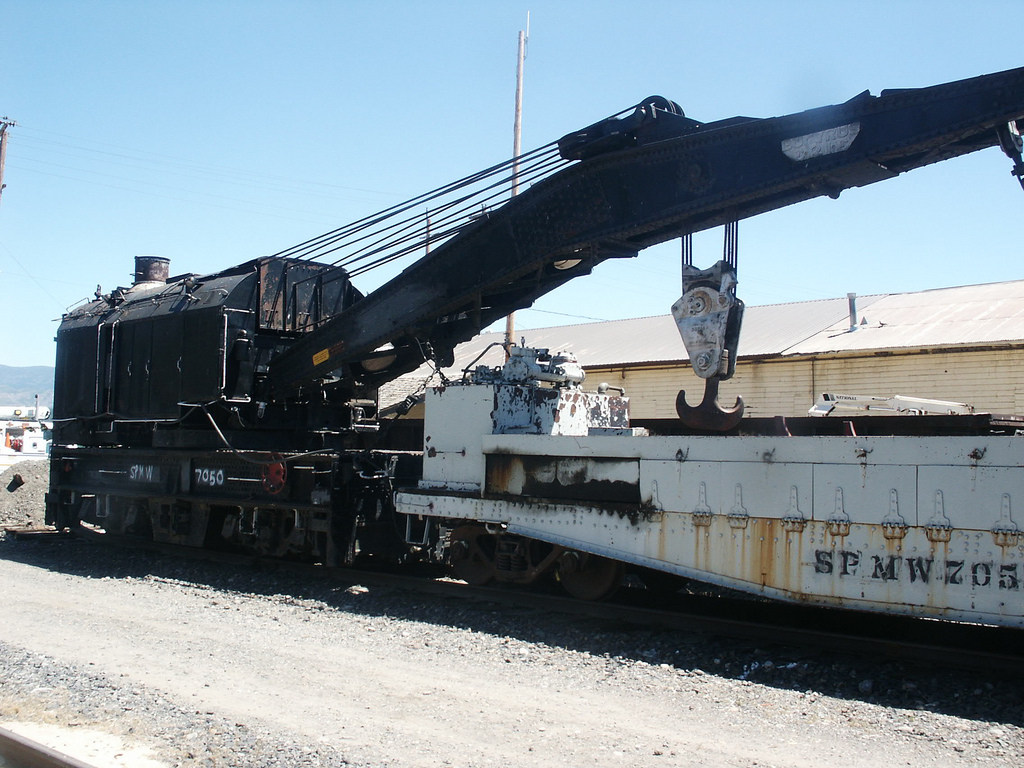Model Information: This model was first introduced by Roco in the 1970s and imported by AHM, Con-Cor and Model Power. The model can be packaged as just the crane, or the crane with a supplementary car. The supplementary car can be an ersatz caboose, boom car (modified flat) or basic flat car.
Prototype History: A complete wreck train consisted of a locomotive, a wreck crane, tool cars, and enough bunk and cook cars for personnel required for a particular wreck. Wreck cranes and tool cars were often stationed at strategic points along the railway line. Division terminals were considered strategic points because locomotives and engine, train, and wreck car crews were always available on call. Wreck train equipment had to be prepared for immediate movement. Ties, rails, spikes, and other repair materials are stockpiled at various points. An emergency supply of such items were also loaded in suitable cars and held with each wrecker as part of the wreck train.
A wreck train, or “relief train” as the railroads preferred to call them used a huge piece of equipment built by companies such as Brownhoist. A typical wrecking crane was powered by twin diesel engines with a 500,000 pound capacity. This crane could easily lift an entire Reading T-1 steam locomotive. At 191-tons, it is a very heavy piece of equipment. It easily outweighs an Alco C630!
A wreck train, or “relief train” as the railroads preferred to call them used a huge piece of equipment built by companies such as Brownhoist. A typical wrecking crane was powered by twin diesel engines with a 500,000 pound capacity. This crane could easily lift an entire Reading T-1 steam locomotive. At 191-tons, it is a very heavy piece of equipment. It easily outweighs an Alco C630!
Road Name History: Maintenance of Way is a generic term that encompasses all activities and equipment related to maintaining railroad tracks in good condition.
Equipment is highly specialized and diversified. A non exhaustive list below:
Equipment is highly specialized and diversified. A non exhaustive list below:
- Ballast cleaner
- Ballast regulator
- Clearance car
- Crane
- Dynamometer car
- Grinder
- Road–rail vehicle (Hi-Rail)
- Rotary snowplow
- Scale test car
- Stoneblower
- Tamping machine
- Track geometry car
Brand/Importer Information: Con-Cor has been in business since 1962. Many things have changed over time as originally they were a complete manufacturing operation in the USA and at one time had upwards of 45 employees. They not only designed the models,but they also built their own molds, did injection molding, painting, printing and packaging on their models.
Currently, most of their manufacturing has been moved overseas and now they import 90% of their products as totally finished goods, or in finished components. They only do some incidental manufacturing today within the USA.
Important Note: The Con-Cor product numbering can be very confusing. Please see here in the article how to properly enter Con-Cor stock numbers in the TroveStar database.
Currently, most of their manufacturing has been moved overseas and now they import 90% of their products as totally finished goods, or in finished components. They only do some incidental manufacturing today within the USA.
Important Note: The Con-Cor product numbering can be very confusing. Please see here in the article how to properly enter Con-Cor stock numbers in the TroveStar database.
Manufacturer Information:  The company was founded in 1960 by Ing. Heinz Rössler and started with a plastic Minitanks series of military vehicles. After export to the USA became successful, the model line was expanded with model trains in HO scale and the smaller N scale. TT scale was also subsequently added to the product line. The model rail product line covers many European countries including Germany, Belgium, Luxembourg, France, Spain, Austria, Italy, Switzerland, Sweden and the Netherlands, and also the USA.
The company was founded in 1960 by Ing. Heinz Rössler and started with a plastic Minitanks series of military vehicles. After export to the USA became successful, the model line was expanded with model trains in HO scale and the smaller N scale. TT scale was also subsequently added to the product line. The model rail product line covers many European countries including Germany, Belgium, Luxembourg, France, Spain, Austria, Italy, Switzerland, Sweden and the Netherlands, and also the USA.
On July 15, 2005 ROCO Modellspielwaren GmbH was declared bankrupt. From July 25 the company continues as Modelleisenbahn GmbH, but still uses the Roco brand and associated logo. On October 1, 2007, distribution of the 'Minitank' product series was assigned to the German model car manufacturer Herpa.
Since February 2008 Modelleisenbahn also owns Fleischmann, which like Roco had gone bankrupt. The two companies continue as separate brands under Modelleisenbahn GmbH, while benefiting from economies of scale through joined development projects, marketing and procurement.
From Wikipedia

On July 15, 2005 ROCO Modellspielwaren GmbH was declared bankrupt. From July 25 the company continues as Modelleisenbahn GmbH, but still uses the Roco brand and associated logo. On October 1, 2007, distribution of the 'Minitank' product series was assigned to the German model car manufacturer Herpa.
Since February 2008 Modelleisenbahn also owns Fleischmann, which like Roco had gone bankrupt. The two companies continue as separate brands under Modelleisenbahn GmbH, while benefiting from economies of scale through joined development projects, marketing and procurement.
From Wikipedia
Item created by: CNW400 on 2019-10-01 14:01:46. Last edited by gdm on 2020-07-17 07:50:09
If you see errors or missing data in this entry, please feel free to log in and edit it. Anyone with a Gmail account can log in instantly.
If you see errors or missing data in this entry, please feel free to log in and edit it. Anyone with a Gmail account can log in instantly.











